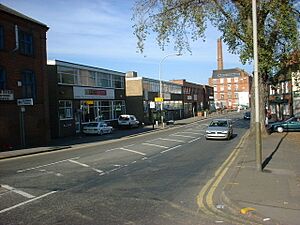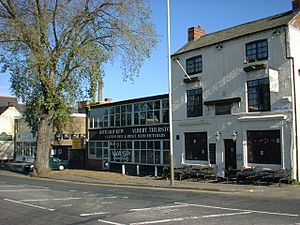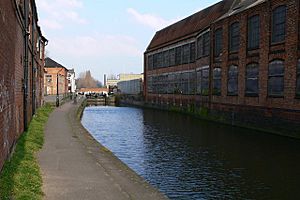Frog Island, Leicester facts for kids
Frog Island is an area in the city of Leicester, England. It gets its name because it sits between the River Soar and the Soar Navigation. The Soar Navigation is a part of the Grand Union Canal. Frog Island is next to the Woodgate area to the north and Northgates to the south.
Contents
How Frog Island Was Formed
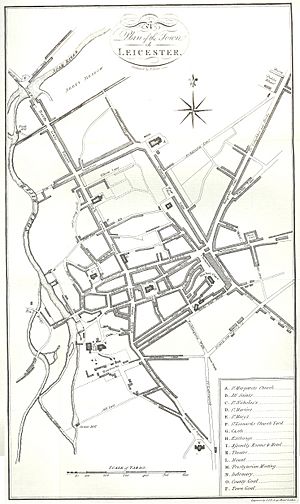
Frog Island is located north of central Leicester. It's also south of the River Soar and Leicester Abbey. This area wasn't always an island. It became one in 1794. This happened when the Soar Navigation was finished.
The navigation project built a new canal section. This new canal helped boats avoid a bend in the River Soar. The land surrounded by the River Soar and this new canal became Frog Island. The main road that crosses this area is also called 'Frog Island'.
A Look at Its History
Frog Island is very close to Leicester Abbey. Historically, parts of it were marshy meadows. These meadows were too wet for building. In 1877, these wet areas were drained. They then became part of Abbey Park.
The main goal of the Leicester Navigation was to make the River Soar usable for trade boats. This was especially important for moving coal from the Leicestershire region. Once the navigation was completed in 1794, goods could travel by boat to the River Trent.
Later, the Leicester to Swannington Railway opened in 1832. This made it even easier to connect coal fields with the Soar and the Grand Union Canal. The Grand Union Canal reaches all the way to London. Frog Island was right in the middle of these important transport links. Because of this, the island became very industrial in the 1800s and 1900s.
By the mid-1900s, many large factories were on Frog Island. They made clothes and machines, especially for making textiles. They also produced materials for the city's hosiery (sock and stocking) trade, like spun wool and dyes. Frog Island had easy access to water from the river and canal. This was very important for dyeing. Water also powered steam and water-driven machines in the factories.
The western part of the island was crossed by the Great Central Main Line. This railway connected Leicester with Sheffield and Nottingham to the north. It also linked to Marylebone station in London. The line was closed in the 1960s as part of a big railway reorganization. Some railway arches from this line are still there. Today, small businesses use these arches. They are made from special blue bricks. These arches were part of a huge bridge that brought the railway into central Leicester.
Old Factories and Buildings
Frog Island's great location near many transport routes made it a key spot for factories. This was true in the 1800s and early 1900s. Many large factories were built, and some are still standing. However, after World War II, many businesses on the island closed down. This period is called "deindustrialisation."
Because of this, many large factory buildings became empty. Some have been damaged by vandals or fires. But some manufacturing still happens on the island. Also, some old industrial features, like the railway arches, are now used for new businesses.
St Leonard's Works (Frisby Jarvis Building)
St Leonard's Works opened in 1867 and was made bigger in 1881. This factory originally spun worsted, which is a type of wool yarn. It was built in the Italian palazzo style. This means it looked like a grand Italian palace. The building used high-quality materials like colored tiles, carved stone, and ironwork. This made it a very impressive building and an important local landmark.
In 1922, Frisby, Jarvis & Co. took over the factory. This company was a major employer in the area. Frisby Jarvis closed in 1992. Another company, Martins Ltd, then took over, but they also closed later. Even though the building was officially protected in 2003, it fell into bad condition. It was badly damaged by fire in 2005.
Farben Works
The Farben Works was another factory that spun worsted wool. It opened in 1914. It was designed in a classical style, meaning it looked like ancient Greek or Roman buildings. It is also a protected historic building. Along with the Slater Street School and Frisby Jarvis works, it is part of an important group of old buildings.
Hitchcock's Flour Mill
Hitchcock's Flour Mill was built in the 1800s. It used water power to run its machines. The mill race, which is the channel of water that powered the mill, is still there. A special Victorian iron bridge crosses it. In 1888, the mill switched to steam power. A fire badly damaged the mill in 2011, and parts of it had to be taken down.
Stephenson's Lifting Bridge
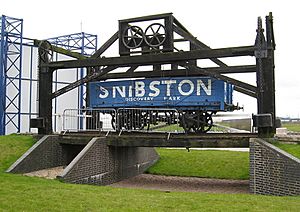
Frog Island was also home to Stephenson's Lifting Bridge. This bridge carried the Swannington Railway over the Soar Navigation. Robert Stephenson, a famous engineer, designed the bridge. It was designed so carefully that one person could operate it by hand. It was removed in the mid-1900s. It was later displayed at Snibston Discovery Museum. Now, it is being rebuilt at the Mountsorrel & Rothley Community Heritage Centre.
Fun and Culture
Next to the canal, you can find 'Stayfree Music'. This place has rooms where bands can practice. There's also 'Lock 42', which is a place for live music and a bar. The Foresters Public House is still open. The North Bridge Tavern is now a private home.
A charity called 27a Access Artspace helps people with disabilities get involved in art. They moved into an old car showroom on Northgate Street in 2008. The West End Gallery also moved to Highcross Street. An old factory building near the canal is sometimes used by artists for exhibitions and art events.
Education
Slater Primary School is in the middle of Frog Island. It serves the Woodgate and Tudor Road areas. There are not many homes on Frog Island itself. Leicester City Council's street lighting depot is located on Slater Street.


